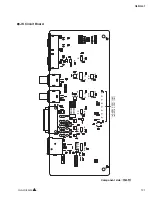
A-2
Reliance with Field Operations Manual
Electromagnetic Fields
A FAMlog offset requires a distance and an azimuth to the target. The azimuth can
come directly from a LRF or manually entered by a field operative. If LRF
measurements are made near ferromagnetic materials, from a moving vehicle or in
close proximity to electric power lines, the electromagnetic fields from these sources
can be greater than the earth’s electromagnetic field. Locally strong magnetic fields
can lead to gross errors in LRF compass measurements, so pay special attention to
these possibilities.
If you are working in an environment with generated electromagnetic fields that are
greater that the earth’s magnetic field, use the right angle survey technique to collect
positions of point features while moving. As the field operative moves along a road,
lase the feature. Add 90’ to the instantaneous trajectory if the feature is to the field
operative’s right, or subtract 90’ from the instantaneous trajectory if the feature is to
the field operator’s left.
Antenna Offset
Antenna height and horizontal offset from the LRF can induce significant errors in
centimeter and decimeter surveys as the antenna location moves farther away from
the LRF. With an antenna mounted on the field operator’s back, and the LRF at the
operator’s eye, the horizontal offset could be up to 30 to 50 centimeters. To minimize
these errors, make the LRF measurement as close to the GPS antenna as possible.
External Sensor Devices
In a typical GPS mapping session, the field operator inspects features visually and
describes them manually using feature files within FAMlog. However not all features
are visible to the user. Water depth, magnetic field strength, temperatures, etc. are
measured automatically and continuously by scientific instruments. If these
Measurements are digitally output by the instruments, FAMlog can record them and
ascribe GPS positions to them.
FAMlog synchronizes the external instrument’s digital output with positional
information from the GPS receiver. Any external sensor device that outputs a NMEA
0183 formatted output message can be used in conjunction with Reliance. This
feature can be particularly useful when measuring line or area features, such as water
depth 5 meters from the shore of a lake.
An external sonar device can be used to measure the water depth, as a GPS receiver
records position on the lake surface. The sonar outputs messages and sends it to the
FS/2. At the same time, GPS receiver sends the very precise information with the time
of the message. FS/2 applies all filters which have been set, and sends combined data
Summary of Contents for Reliance FS/2
Page 2: ...ii Reliance with FS 2 Field Operations Manual FS 2 Screen Map...
Page 6: ...vi Reliance with FS 2 Field Operations Manual...
Page 14: ...xiv Reliance with FS 2 Field Operations Manual...
Page 26: ...10 Reliance with FS 2 Field Operations Manual...
Page 150: ...134 Reliance with FS 2 Field Operations Manual...
Page 158: ...B 4 Reliance with FS 2 Field Operations Manual...
Page 160: ...C 2 Reliance with FS 2 Field Operations Manual Figure C 1 FS 2 Handheld Controller...
Page 170: ...C 12 Reliance with FS 2 Field Operations Manual...
Page 176: ...E 4 Reliance with FS 2 Field Operations Manual...
Page 182: ...F 6 Reliance with FS 2 Field Operations Manual...
















































